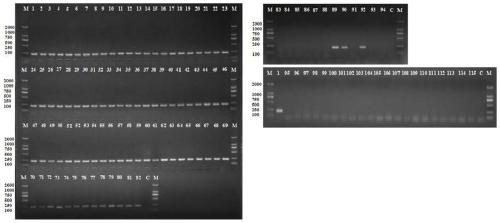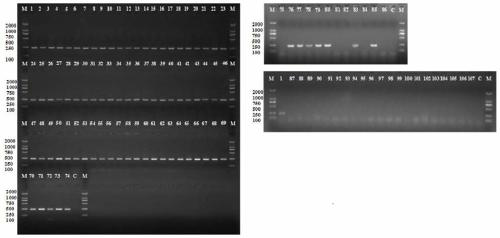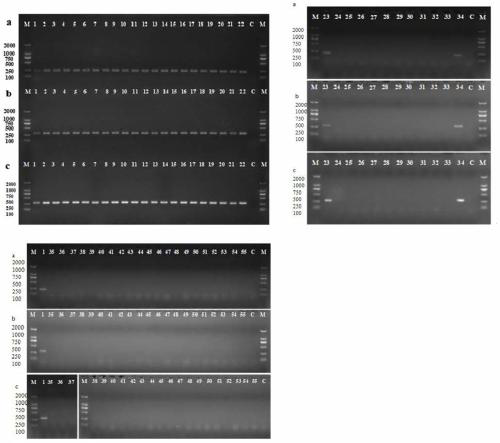Serotype listeria monocytogenes specific new molecular targets and rapid detection method thereof
A Listeria and molecular target technology, applied in the field of microbial testing, can solve the problems that have not yet been found, and reports that no PCR method has been established, and achieve the effects of simple result judgment, practicability, and specific test results.
- Summary
- Abstract
- Description
- Claims
- Application Information
AI Technical Summary
Problems solved by technology
Method used
Image
Examples
Embodiment 1
[0038] Example 1 Mining of new molecular targets specific to common serotypes of Listeria monocytogenes
[0039] According to the GenBank database and the complete genome DNA sequences of different serotypes of Listeria monocytogenes self-tested by our team, through comparative genomics analysis, the common serotypes of Listeria monocytogenes Non-essential genes specific to terpene strains. The MP method in the prokaryotic pan-genome automated analysis software PGAP is used for analysis, and the analysis results are processed through the local Perl script to obtain the core gene and non-core gene information of all strains, and to screen out common serotypes of Listeria monocytogenes specific gene fragments. The gene sequence is shown in SEQ ID NO.1-SEQ ID NO.13. Extract the 13 specific gene protein sequences unique to the target serotype Listeria monocytogenes strains, and compare them back to the total protein library of Listeria monocytogenes and the NCBI non-redundant pr...
Embodiment 2
[0040] Example 2 Establishment of rapid detection method for Listeria monocytogenes lineage type I specific new molecular target
[0041] This embodiment provides a method for detecting Listeria monocytogenes lineage type I strains: design primers according to the new specific molecular targets of Listeria monocytogenes lineage type I, and form a rapid detection method, including the following steps:
[0042] Primer design: Design specific amplification primers according to the new specific molecular target base sequence SEQ ID NO.1. The primer sequences are as follows:
[0043] Table 1 Sequences of primers for Lineage I specific PCR detection of Listeria monocytogenes
[0044]
[0045] DNA template preparation: The Listeria monocytogenes lineage type I strain was enriched in BHI liquid medium, and the bacterial genomic DNA was extracted using a commercial bacterial genomic DNA extraction kit as a template to be tested.
[0046] PCR detection system and amplification proce...
Embodiment 3
[0056] Example 3 Establishment of a Rapid Detection Method for Listeria monocytogenes Lineage Type II Specific New Molecular Targets
[0057] This example provides a method for detecting Listeria monocytogenes lineage type II strains: design primers according to the new specific molecular targets of Listeria monocytogenes lineage type II, and form a rapid detection method, including the following steps:
[0058] Design of primers: Design specific amplification primers according to the base sequence of the new specific molecular target base sequence SEQ ID NO.2. The primer sequences are as follows:
[0059] Table 3 The sequence of primers for detection of Listeria monocytogenes lineage type Ⅱ specific PCR
[0060]
[0061] Preparation of DNA template: The Listeria monocytogenes lineage type II strain was enriched and cultured in BHI liquid medium, and the bacterial genomic DNA was extracted using a commercial bacterial genomic DNA extraction kit as a template to be tested. ...
PUM
 Login to view more
Login to view more Abstract
Description
Claims
Application Information
 Login to view more
Login to view more - R&D Engineer
- R&D Manager
- IP Professional
- Industry Leading Data Capabilities
- Powerful AI technology
- Patent DNA Extraction
Browse by: Latest US Patents, China's latest patents, Technical Efficacy Thesaurus, Application Domain, Technology Topic.
© 2024 PatSnap. All rights reserved.Legal|Privacy policy|Modern Slavery Act Transparency Statement|Sitemap



